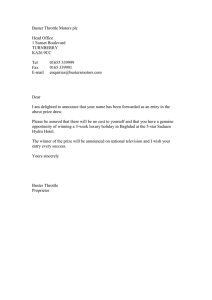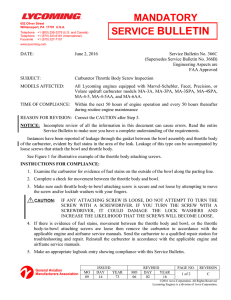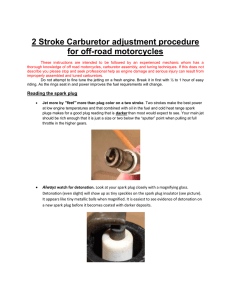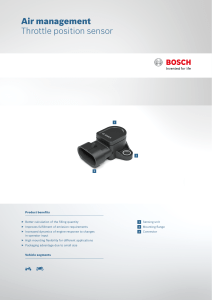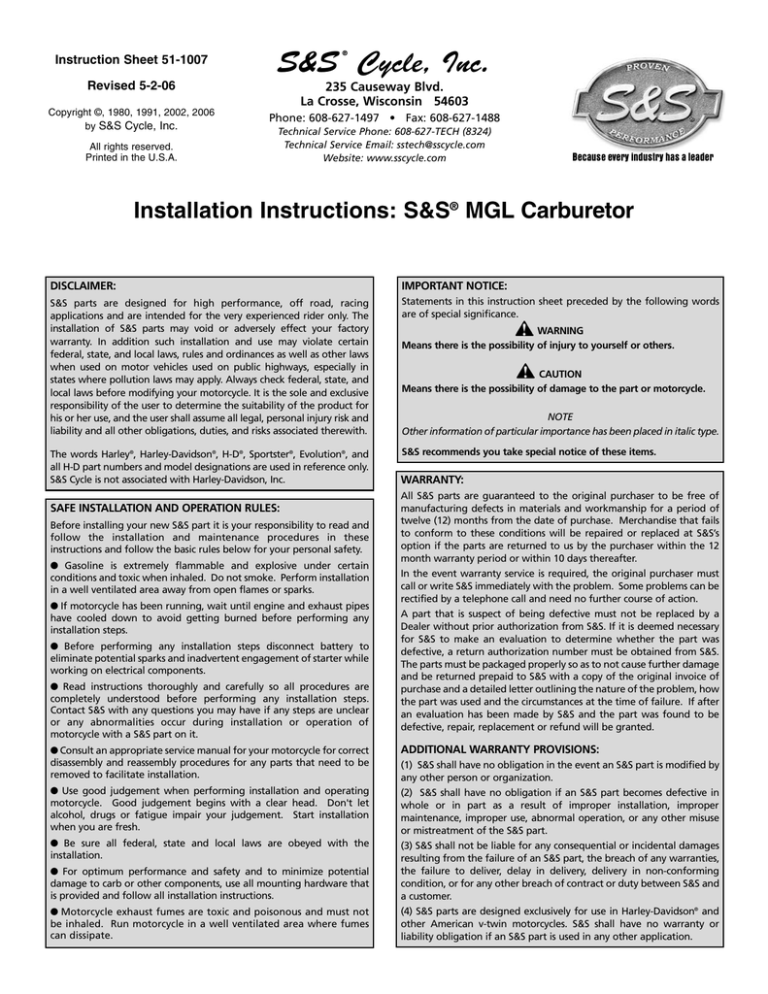
Instruction Sheet 51-1007
S&S Cycle, Inc.
®
Revised 5-2-06
235 Causeway Blvd.
La Crosse, Wisconsin 54603
Copyright ©, 1980, 1991, 2002, 2006
by S&S Cycle, Inc.
Phone: 608-627-1497 • Fax: 608-627-1488
All rights reserved.
Printed in the U.S.A.
Technical Service Phone: 608-627-TECH (8324)
Technical Service Email: sstech@sscycle.com
Website: www.sscycle.com
Because every industry has a leader
Installation Instructions: S&S® MGL Carburetor
DISCLAIMER:
IMPORTANT NOTICE:
S&S parts are designed for high performance, off road, racing
applications and are intended for the very experienced rider only. The
installation of S&S parts may void or adversely effect your factory
warranty. In addition such installation and use may violate certain
federal, state, and local laws, rules and ordinances as well as other laws
when used on motor vehicles used on public highways, especially in
states where pollution laws may apply. Always check federal, state, and
local laws before modifying your motorcycle. It is the sole and exclusive
responsibility of the user to determine the suitability of the product for
his or her use, and the user shall assume all legal, personal injury risk and
liability and all other obligations, duties, and risks associated therewith.
Statements in this instruction sheet preceded by the following words
are of special significance.
The words Harley®, Harley-Davidson®, H-D®, Sportster®, Evolution®, and
all H-D part numbers and model designations are used in reference only.
S&S Cycle is not associated with Harley-Davidson, Inc.
SAFE INSTALLATION AND OPERATION RULES:
Before installing your new S&S part it is your responsibility to read and
follow the installation and maintenance procedures in these
instructions and follow the basic rules below for your personal safety.
● Gasoline is extremely flammable and explosive under certain
conditions and toxic when inhaled. Do not smoke. Perform installation
in a well ventilated area away from open flames or sparks.
● If motorcycle has been running, wait until engine and exhaust pipes
have cooled down to avoid getting burned before performing any
installation steps.
● Before performing any installation steps disconnect battery to
eliminate potential sparks and inadvertent engagement of starter while
working on electrical components.
● Read instructions thoroughly and carefully so all procedures are
completely understood before performing any installation steps.
Contact S&S with any questions you may have if any steps are unclear
or any abnormalities occur during installation or operation of
motorcycle with a S&S part on it.
WARNING
Means there is the possibility of injury to yourself or others.
CAUTION
Means there is the possibility of damage to the part or motorcycle.
NOTE
Other information of particular importance has been placed in italic type.
S&S recommends you take special notice of these items.
WARRANTY:
All S&S parts are guaranteed to the original purchaser to be free of
manufacturing defects in materials and workmanship for a period of
twelve (12) months from the date of purchase. Merchandise that fails
to conform to these conditions will be repaired or replaced at S&S’s
option if the parts are returned to us by the purchaser within the 12
month warranty period or within 10 days thereafter.
In the event warranty service is required, the original purchaser must
call or write S&S immediately with the problem. Some problems can be
rectified by a telephone call and need no further course of action.
A part that is suspect of being defective must not be replaced by a
Dealer without prior authorization from S&S. If it is deemed necessary
for S&S to make an evaluation to determine whether the part was
defective, a return authorization number must be obtained from S&S.
The parts must be packaged properly so as to not cause further damage
and be returned prepaid to S&S with a copy of the original invoice of
purchase and a detailed letter outlining the nature of the problem, how
the part was used and the circumstances at the time of failure. If after
an evaluation has been made by S&S and the part was found to be
defective, repair, replacement or refund will be granted.
● Consult an appropriate service manual for your motorcycle for correct
disassembly and reassembly procedures for any parts that need to be
removed to facilitate installation.
ADDITIONAL WARRANTY PROVISIONS:
● Use good judgement when performing installation and operating
motorcycle. Good judgement begins with a clear head. Don't let
alcohol, drugs or fatigue impair your judgement. Start installation
when you are fresh.
(2) S&S shall have no obligation if an S&S part becomes defective in
whole or in part as a result of improper installation, improper
maintenance, improper use, abnormal operation, or any other misuse
or mistreatment of the S&S part.
● Be sure all federal, state and local laws are obeyed with the
installation.
● For optimum performance and safety and to minimize potential
damage to carb or other components, use all mounting hardware that
is provided and follow all installation instructions.
(3) S&S shall not be liable for any consequential or incidental damages
resulting from the failure of an S&S part, the breach of any warranties,
the failure to deliver, delay in delivery, delivery in non-conforming
condition, or for any other breach of contract or duty between S&S and
a customer.
● Motorcycle exhaust fumes are toxic and poisonous and must not
be inhaled. Run motorcycle in a well ventilated area where fumes
can dissipate.
(4) S&S parts are designed exclusively for use in Harley-Davidson® and
other American v-twin motorcycles. S&S shall have no warranty or
liability obligation if an S&S part is used in any other application.
(1) S&S shall have no obligation in the event an S&S part is modified by
any other person or organization.
The S&S® MGL series carburetor has been designed for performance applications to be used on large displacement
Harley-Davidson® big twin and Sportster® models. We do not recommend using this carburetor on stock Sportster®
models and 74’s. The carburetor has a fixed main jet, fixed intermediate jet and intermediate air bleed, and an
adjustable idle mixture screw. It is made in the 17/ 8” throat size only. This carburetor has a conventional choke for
starting.
be determined. Hold the throttle cable housing in
The S&S MGL series carburetor kit contains the
position at the throttle grip and at the throttle
following items:
cable boss on the carburetor and adjust to the
Carburetor
desired length. Cut the cable housing only. Install
Intake manifold and bolts
the throttle cable into the throttle cable housing
Air cleaner w/mounting bracket
and throttle grip and thread them through the boss
Fuel line w/two clamps
and throttle cable clamp. Note where the throttle
Two extra main jets
cable clamp comes on the cable. This portion
One tie strap
should be soldered to prevent the strands from
separating. Any additional cable must be cut off.
1. The old carburetor and manifold must be removed
Lubricate the throttle assembly and cable during
and the manifold supplied with the kit installed. If
the final installation. Leave a little freeplay in the
the carburetor is to be used on a knucklehead or
throttle when tightening the throttle cable clamp
panhead, a bracket that goes from the center
screw so the throttle will close all the way. Any
crankcase stud to the bottom manifold bolt is
excessive play can be adjusted out at the throttle
furnished. The bottom manifold bolt supplied is 1/ 4”
grip before engine start-up. Important: After all
longer (11/ 4” overall length) and must be used in the
cable adjustments are made, be sure that the
bottom hole only. The top manifold bolt is 1” long.
throttle works freely and returns to the fully
For installation on Sportster® models, a bracket is
closed position when the throttle is released
furnished that goes from the front intake cam stud
to the air cleaner backplate. On shovelheads, a
bracket that goes from the front cylinder rocker box
WARNING
cover to the backplate is used. Temporarily bolt the
Most
English
type
throttles
have a friction screw that
carburetor in place.
dampens the self-closing feature on these throttles.
When over-tightened, the throttle will not close to the
2. An English type throttle must be used since the MGL
idle position when the hand is removed from the
has a built-in throttle return spring. The stock
throttle grip. Operation under this condition is not
Harley-Davidson® throttle on 1974 and later models
recommended because of the possible hazard
can be adapted by soldering the last 11/ 2” of inner
involved when the engine will not stop automatically
cable before cutting the ball or barrel fitting off the
in an emergency.
end. The soldering is done to prevent the strands
from separating. Once this operation is done,
remove the carburetor and feed the cables through
WARNING
the throttle cable boss on the carburetor body, the
We do not recommend the use of quick or 1/ 4 turn
soldered portion of the braided cable extending
throttles. They are not only dangerous but also
into the throttle cable clamp on the throttle arm. A
adversely affect the throttling characteristics of the
little freeplay should be left in the throttle when
carburetor.
the screw on the throttle cable clamp is tightened.
Any excessive play can be adjusted out at the
3. After installing the throttle assembly, make certain
throttle grip before engine start-up.
that the O-ring is in place at the end of the
For those bikes that are not already equipped with
an English throttle, one can be purchased
separately. To install, remove the old throttle by
loosening the screw at the end of the handlebar.
Drive the ring the twistgrip is shouldered against
off the handlebar. Slip the furnished spacer on the
handlebar. If 1" handlebars are used, do not use
the spacer. Next, install the throttle assembly on
the handlebar and temporarily tighten in the
desired position. The throttle cable supplied is extra
long to compensate for different length
handlebars. Turn the handlebars to the extreme left
position so that the length of the cable needed can
2
carburetor and bolt the carburetor in place using
the allen head bolts provide.
NOTE: For installation in big twins, the stock wire fuel
line bracket should be used to position the fuel line
between the cylinders.
4. The fuel line supplied should be used in place of the
stock line. For Harley-Davidson® Sportster® models
with the straight feed type petcock, the line is bent
sharply over the throttle cable housing boss toward
the air cleaner backplate between the carburetor
body and the throttle cable. It should then bend
around, forward, to the bowl inlet fitting. A tie
strap is provided to hold the line tight to the
carburetor body. It must be fastened directly behind
the air cleaner backplate around the carburetor
body and fuel line. Secure both ends of the fuel line
with the clamps provided.
6. Special instructions for engines equipped with
breather vent line to the air cleaner:
S&S® air cleaners have a special boss cast into the air
cleaner backplate designed especially for this vent.
The backplate should be drilled and tapped for a 1/ 8”
pipe nipple. This can be purchased at most any
hardware store. After the air cleaner backplate
modification is done, the vent line should be
secured with a clamp.
WARNING
The fuel line must not interfere with the operation of
the throttle in any way. See Picture 1 for proper
installation.
For Sportster® models equipped with the 90-degree
bend, feed type petcock, the line is angled slightly
forward toward the air cleaner backplate, bending
down between the bowl and the throttle cable to
the bowl inlet fitting. Secure both ends of the fuel
line with the clamps provided. See Picture 2 for
proper installation.
Picture 1
The fuel line on big twins can normally be routed
between the cylinders.
Check for leaks before starting the engine.
WARNING
Some bikes are equipped with exhaust systems that
curve around the gear cover directly under the
carburetor. The fuel line must not touch the pipe or be
placed in a position where it is exposed to extreme
heat.
5. With the fuel line in place, the air cleaner backplate
and mounting bracket can be installed. The
Sportster® models bracket bolts to the front intake
cam cage stud and the shovelhead bracket bolts to
the front rocker box cover. A short spacer is
provided with the air cleaner bracket mounting
hardware that must be installed between the
bracket and backplate. Immerse the foam portion
of the air cleaner element in a light weight engine
oil and squeeze out. Before final assembly of the air
cleaner, check the needle and seat for possible
leakage. Lean the motorcycle over slightly to the
right and turn the fuel petcock on. If gas does not
leak out of the end of the carburetor after 10
seconds, the element and air cleaner cover can be
installed. If the needle and seat do not hold, the
bowl should be removed and checked.
Picture 2
A. Starting Procedure
1. This carburetor has a conventional choke type
starting mechanism. It has a tension spring, Part
No. 144 that constantly applies pressure against
the choke lever, Part No. 146 so that it will
remain in position once set. The choke plate,
Part No. 73, is fully closed when the lever is
pulled up to the stop.
3
B. Cold Starts:
1. Pull the choke lever up to the fully closed
position. Open the throttle and kick the engine
through two or three times. Then, with the choke
half open, switch on, and the throttle slightly
cracked, kick the engine through. For colder
weather, 50° and below, or for instances where
the engine has not been run recently, it may be
necessary to prime the engine with an additional
kick. After the engine starts, push the choke lever
to the wide open position and jockey the throttle
slightly to keep the engine running.
C. Hot Start:
1. Hot starting does not normally require the use
of the choke. Starting is usually accomplished by
turning on the ignition and kicking with the
throttle closed.
D. Electric Start Models:
1. Close the choke halfway, turn on the ignition,
and with the throttle slightly cracked engage
the starter. After the engine starts, open the
choke and work the throttle slightly until the
engine will idle by itself.
E. Troubleshooting Tip - Engine will not start:
1. Fuel supply empty.
2. Weak or no spark - discharged battery or
faulty magneto.
NOTE: We do not recommend the use of magnetos.
3. Plug gap too wide - we use .020 to .022 plug gap
on our point type ignition engines.
4. Improper ignition timing.
5. Tight tappet adjustment.
6. Improper idle mixture and/or engine RPM
setting.
7. Intermediate air bleed loose.
8. Improper diagnosis of a rich or lean mixture
condition. If the engine fires in the carb, it is too
lean and must be re-primed. Do not continue to
kick the engine over with the switch on until it
is re-primed. If there . is no response after three
kicks or if it pops in the exhaust pipes, it is too
rich. Leave the switch on and open the throttle
a 1⁄4 turn with each successive kick until it fires.
4
Adjusting the Carburetor
Idle Circuit:
The idle mixture screw, Part No. 54, is initially set during
assembly to 11⁄2 turns out from the fully closed position.
Check this and reset the screw to 11⁄2 turns before
attempting to start the engine.
CAUTION
Never close the idle mixture screw tightly as damage to
the needle and seating area in the carburetor body may
result.
The throttle stop engine RPM adjustment screw
located on the throttle arm, Part No. 48, is initially set
by holding the throttle closed and turning the screw
until it contacts the throttle arm stop boss. At this
point it is turned an additional 1⁄2 turn clockwise. Start
the engine and warm it up to operating temperature.
Adjust the engine RPM to a slow idle, approximately
600 to 800 RPM. Then turn the idle mixture screw in,
leaning it, until the engine starts to die. Next, turn the
screw back out, richening it, until it starts to die. A
position about halfway between these points, or a
setting of about 1⁄4 to 1⁄2 a turn out from the lean side
of the range is the correct setting. From the fully
closed position this would be approximately 11⁄4 to 13⁄4
turns. Then set the throttle stop screw to give final
desired RPM idle speed. Idle speeds will vary
according to the individual and the use to which the
machine is put.
NOTE Whenever an intermediate jet change is made,
the idle mixture screw should be readjusted.
Troubleshooting Tip- - Engine will not idle:
1.
2.
3.
4.
Improper idle mixture and/or engine RPM setting.
Intake manifold air leak.
Sticky timing automatic advance mechanism.
Foreign material obstructing gas flow to idle circuit.
Intermediate System—
Intermediate jet:
For normal riding conditions, the intermediate range is
used the most. Therefore, close attention must be paid
to jetting the midrange to achieve optimum
performance and gas mileage. Once the engine is
warmed up and the idle mixture and engine RPM screws
set, the bike must be road tested. The intermediate
range is used from right off idle up to approximately
3500 RPM or 50 to 60 MPH depending on gearing. If,
while maintaining a steady speed, popping or spitting
occurs regularly in the air cleaner, the intermediate jet,
Part No. 153, should be changed to the next larger size.
(The size is stamped on the end of the tube.) This
spitting is a lean condition and must be corrected. The
smallest idle tube that eliminates this condition should
provide the best gas mileage. For better throttling
characteristics and performance. a richer idle tube, one
or two sizes larger, may be necessary. This is especially
true if the bike is to be used exclusively on a drag strip.
Larger jets or richer mixtures will enable one to run a
colder engine which is sometimes desirable. This is best
determined by experimentation with the particular
engine to be used. Gas mileage is oftentimes determined
by an individual’s riding habits. Snapping the throttle
open in the lower RPM ranges is an inefficient way of
operating the bike. S&S® carbs are not equipped with
accelerator pumps. Consequently, poor throttling
characteristics may occur since the intermediate system is
effectively bypassed. The engine will respond better if
the throttle is rolled on.
Intermediate Air Bleed
one desires to become proficient at plug reading.
Champion Racing Division has a very informative
booklet. For details write:
Champion Spark Plug Co.
PO. Box 910
Toledo, Ohio 43601
If main jetting tests cannot be conducted at the drag
strip, the “RPMing” method can be used. This procedure
would be to run the bike through the gears noting how
quickly and smoothly the engine reaches the RPM level
where gears are shifted. Under racing conditions this
level is where horsepower peaks and begins to taper off.
The main jet that makes the engine pull the strongest or
RPM through the gears best is the correct one. Our
experience is that a jet about .006 smaller (leaner) in size
will make the engine pop and sputter or “break up” in
the carburetor and die. A jet about .006 larger (richer)
will make the engine run flat and sluggish or “blubber”.
The intermediate air bleed, Part No. 151, is located
directly adjacent to the intermediate jet. All carburetors
have an intermediate air bleed because it is necessary to
correct the air/fuel ration over the whole intermediate
range. For most practical purposes, a .040 intermediate
air bleed is used to do this. Larger (more air or leaner
fuel mixture) or smaller (less air or richer fuel mixture)
air bleeds are available, but caution must be exercised
when changing these. Example: a larger air bleed could
cause a leaner fuel mixture in a riding range that over a
period may destroy the engine due to detonation or
seizing. The best advice is to leave the air bleed alone.
Main Jet - from 3500 RPM or 55-60 MPH on up:
Main jetting is best determined by testing at the drag
strip. Jetting should always be done at operating
temperature. After a run is made, the engine RPM and
final speed should be noted. A second run should be
made with a .004 larger (richer) jet installed. Again, RPM
and final speed is noted. This procedure should be
continued until the miles per hour falls off. The main jet
should then be made smaller (leaner) to gain the best
maximum RPM and MPH. When making these runs, do
not strive for ETs, but for consistent miles per hour. We
have found that maximum miles per hour and RPM have
been the best indicators of proper jetting.
If the engine is buttoned off after each run, the
sparkplugs may be inspected for richness or leanness. Plug
color is not always a good indication of carb jetting on
quarter mile tests. We have found that different brands of
gasoline, gasoline additives, engine heat (due to ignition
timing), and type of plugs and heat range used alter
readings drastically. New plugs usually require the time
involved in a road test to properly develop the plug color.
It is best to use a proven combination and to consult the
sparkplug manufacturer,for more specific information if
5
Troubleshooting Tip-— Engine will not run at Steady
Speed:
1. Restriction in fuel supply system - gas tank vent
plugged, gas petcock too small (stock HarleyDavidson® petcock is adequate, but might require
running on “reserve” to provide adequate supply for
big inch engines), needle and seat assembly not
working properly.
2. Faulty ignition system - fouled plugs, worn points,
defective coil.
3. Incorrect intermediate and/or high speed jetting.
4. Foreign material in air bleeds, intermediate jet, main
jet, and/or passageways in carb causing flow
restriction.
5. Air cleaner is other than S&S®, or no cleaner is used.
Some air cleaner designs are such that the carb
cannot draw air freely as it is needed.
6. Valve train defect - bad valves, sticky valves, bad
or broken springs, improper clearances for high
lift cams.
Engine will not RPM:
1.
2.
3.
4.
5.
6.
7.
8.
Restriction in fuel system.
Faulty ignition system.
Incorrect high speed jetting.
Foreign material in air and/or gas passageways in
carb causing flow restriction .
Air horn being used without shrouding bowl vent. (If
the bowl vent is not shrouded, the air pressure in the
bowl is different from atmospheric pressure.)
Incorrect air cleaner being used.
Too much gear. (Not enough horsepower to pull
the gearing.)
Valve train defect.
General Information
1. Do not chrome the carburetor as extensive damage
will result.
2. The carburetor has several drilled passages that are
permanently sealed with three drive plugs. Do not
attempt to remove these plugs.
3. Do not over-tighten the idle mixture screw,
intermediate jet, or intermediate air bleed.
4. Do not attempt to remove the small 1⁄8” diameter
tube near the choke in the carburetor body. This is
the main jet air bleed and is permanently pressed
into the body.
5. The float level is 3⁄4” when measured from the top
of the float to the scribed line on the bowl gasket
surface. This is done with needle in the closed
position.
6. When the motorcycle is not running, the fuel shutoff
valve should be turned off.
6
7. The throttle plate, Part No. 55, and throttle shaft,
Part No. 83, should be checked annually for signs of
wear. Replace, if necessary. If they are removed, be
sure that the throttle plate is reinstalled correctly.
See Figure A.
8. If the throttle arm, Part No. 48, is removed from the
throttle shaft, it must be reinstalled in the wide open
position with the butterfly at 90-degrees to the fully
closed position. See Figure B.
9. If an air cleaner other than ours must be used, make
sure the bowl vent hole on the inlet end of the
carburetor is not covered and sealed off.
10. Cams and exhaust systems make some engines
difficult to carburate. A combination of cam overlap
and back pressure, or lack of back pressure will cause
mixture dilution at certain engine RPMs. This
dilution will cause engine roughness or misfiring
when the engine is held in this range. To attempt to
carburate for this condition usually destroys the
carburation over the rest of the range. It is best
under these conditions to change the cam and/or the
exhaust system.
The MGL has an adjustable idle mixture screw, a fixed
intermediate jet, a fixed intermediate air bleed, and a fixed
main jet.
The idle mixture screw, Part No. 54, is located on top of
the carburetor. Turning the screw in, clockwise, will lean
the mixture. A counterclockwise motion, out, will richen
the mixture.
The intermediate jet, Part No. 153, is screwed into the
carburetor on the top of the body. It is made in sizes .028,
.029, .030, .031, .032, .033 a .035; .035 being the richest.
The intermediate air bleed, Part No. 151, works in
conjunction with the idle screw and intermediate jets
and is located adjacent to the intermediate jet. The air
bleed required on all of our test engines was .040. For
those who must have larger or smaller ones, they can be
ordered on special request.
The main jet, Part No. 72, is made in increments of .002
and range in size from .060 to .104. It can be reached by
removing the bowl assembly.
Below is a chart with some basic guidelines to follow while jetting your MGL.
Jetting Tips
Stock CID
Mild Strokers
Strokers
Strokers
Big Twin
74”
80” - 84”
86” - 94”
96”-Up
Sportster
models
*
Up to 77”
78” - 87”
89”-Up
Idle Mixture
Screw
11⁄4 -13⁄4 Turns
11⁄4 -13⁄4 Turns
11⁄4 -13⁄4 Turns
11⁄4 - 13⁄4 Turns
No. 31 - No. 33
No. 32 - No. 35
®
Intermediate
Jet
No. 29 - No. 32 No. 29 - No. 33
Intermediate
Air Bleed
40
40
40
40
Main Jet
68 - 76
70 - 76
72 - 80
74 - 84
NOTE: We have determined that the MGL works best on large displacement engines with valve train, headwork
and/or exhaust changes. Stock or small displacement engines do not throttle as well.
7
45.
48.
52.
54.
55.
56.
57.
58.
59.
60.
62.
63.
64.
65.
66.
67.
69.
70.
72.
73.
74.
75.
77.
78.
Choke-throttle plate screw
Throttle arm assembly
Idle mixture screw spring
Idle mixture screw
Throttle plate
0-ring
1” spacer
Y manifold - (all Harley-Davidson® Sportster®
models shovelheads up to 1980)
Manifold screw - top, 2"
Manifold screw - bottom, 21⁄4"
Manifold screw - top, 1"
Manifold screw - bottom -11⁄4"
Panhead manifold (1955-1965 only)
Seat
Lock washer
Bowl screw
Float pin
Bowl gasket
Main jet
Choke plate
Main discharge tube
Bottom plug
Air cleaner cover screw
Air cleaner cover
79.
82.
83.
91.
92.
93.
95.
96.
97.
98.
101.
143.
144.
146.
147.
149.
151.
153.
158.
168.
171.
180.
199.
Air cleaner element
Throttle return spring
Throttle shaft
Air cleaner backing plate screw
Air cleaner support bracket - shovelhead
Air cleaner support bracket - CH
Needle
Support bracket - Panhead
Support bracket bolt
Support bracket locknut
Support bracket spacer
Choke arm screw
Choke spring
Choke shaft assembly
Body
Choke washer
Intermediate air bleed
Intermediate jet
Y manifold - for late 1980 to present
shovelheads, manifold available but not pictured)
Bowl
Float
Air cleaner backing plate
Air cleaner - complete assembly
59
58
60
56
57
153
54
82
83
144
149
143
151
52
55
62
147
180
48
63
79
73
78
91
168
72
74
75
66
171
70
67
98
95
92
101
97
8
69
65
93
77
96
64
146
45
199
56
45

